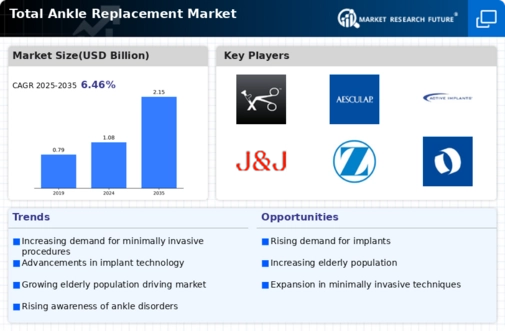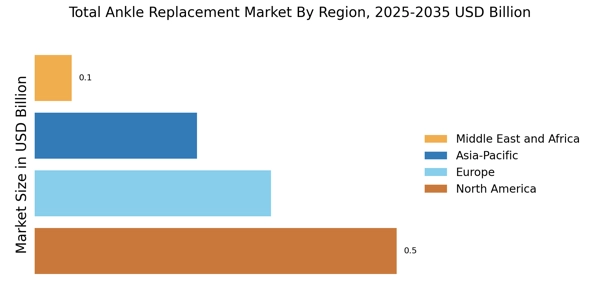Growing Geriatric Population
The demographic shift towards an aging population is significantly influencing the Total Ankle Replacement Market. As individuals age, they are more susceptible to degenerative joint diseases, which often necessitate surgical intervention. Projections indicate that by 2030, the number of individuals aged 65 and older will reach approximately 1.5 billion, creating a substantial patient base for ankle replacement surgeries. This demographic trend suggests a sustained increase in demand for total ankle replacements, as older adults seek to maintain mobility and quality of life. Consequently, the Total Ankle Replacement Market is poised for growth, driven by the need to address the orthopedic challenges faced by the aging population.
Rising Incidence of Ankle Disorders
The Total Ankle Replacement Market is experiencing growth due to the increasing prevalence of ankle disorders, including arthritis and post-traumatic conditions. As the population ages, the incidence of these disorders is likely to rise, leading to a greater demand for effective treatment options. According to recent data, approximately 1 in 10 adults suffer from some form of ankle-related issues, which necessitates surgical interventions. This trend suggests that more patients may seek total ankle replacement as a viable solution, thereby driving market expansion. Furthermore, advancements in surgical techniques and implant designs are making these procedures more accessible and successful, further contributing to the growth of the Total Ankle Replacement Market.
Increased Investment in Healthcare Infrastructure
Investment in healthcare infrastructure is a crucial driver for the Total Ankle Replacement Market. Governments and private entities are increasingly allocating resources to enhance surgical facilities and improve patient care. This trend is particularly evident in regions where healthcare access has historically been limited. Enhanced infrastructure facilitates the adoption of advanced surgical techniques and technologies, thereby improving patient outcomes. As more healthcare facilities become equipped to perform total ankle replacements, the market is likely to expand. Furthermore, increased funding for orthopedic research and development may lead to innovative solutions that further enhance the Total Ankle Replacement Market.
Technological Advancements in Surgical Techniques
Technological innovations are playing a pivotal role in the Total Ankle Replacement Market. The introduction of robotic-assisted surgery and computer-assisted navigation systems has enhanced the precision and outcomes of ankle replacement procedures. These advancements not only improve surgical efficiency but also reduce recovery times for patients. Data indicates that minimally invasive techniques, which are becoming increasingly popular, can lead to shorter hospital stays and quicker rehabilitation. As healthcare providers adopt these technologies, the Total Ankle Replacement Market is likely to witness a surge in demand, as patients are more inclined to opt for procedures that promise better results and faster recovery.
Rising Awareness and Acceptance of Ankle Replacement Procedures
There is a notable increase in awareness and acceptance of total ankle replacement procedures among patients and healthcare providers, which is positively impacting the Total Ankle Replacement Market. Educational campaigns and patient advocacy groups are playing a vital role in informing individuals about the benefits of ankle replacement surgery. As patients become more informed about their treatment options, they are more likely to consider total ankle replacement as a viable solution for chronic ankle pain. This growing acceptance is reflected in the rising number of procedures performed annually, suggesting a robust future for the Total Ankle Replacement Market as more individuals seek effective solutions for their ankle-related issues.


















Leave a Comment